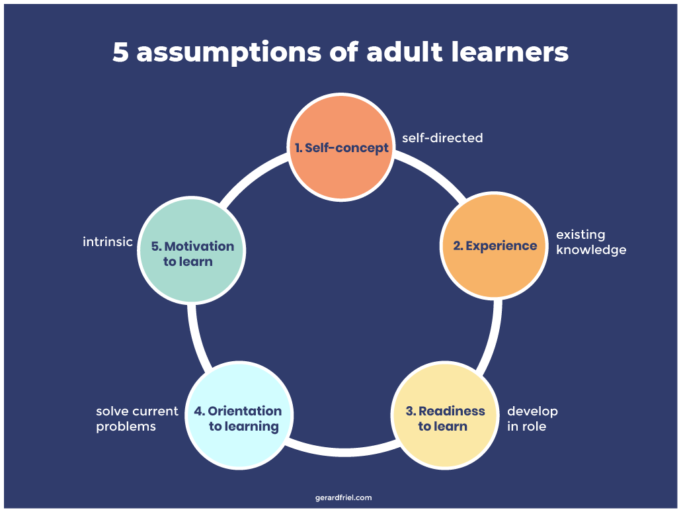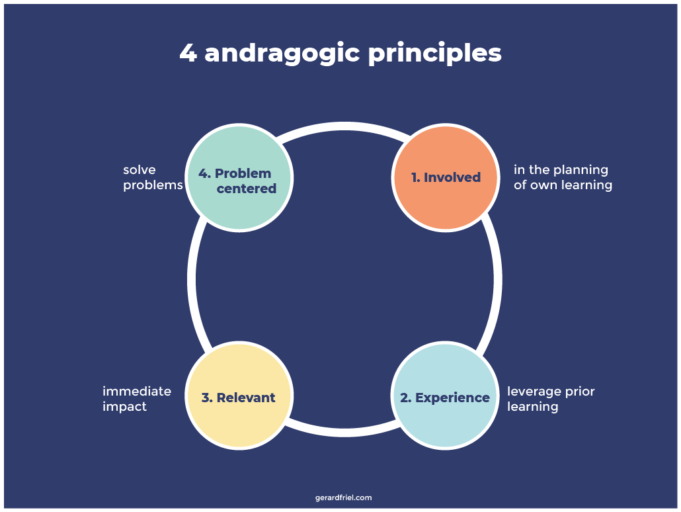The art and science of helping adults learn.
What is Adult Learning Theory?
Adult learning is a collection of assumptions and principles to guide the design of adult learning. It results in content and activities that are relevant and effective whilst providing learners with an engaging experience.
During the 1980’s, the American educator Malcolm Knowles popularised the term Andragogy (Greek for adult rather than child learning) and produced a theory that moved away from traditional pedagogy (child learning) to focus on the characteristics of an adult audience. His ‘Adult Learning Theory’ consists of five assumptions and four principles that designers should consider when developing learning content for adults.

5 assumptions of adult learners:
- Self-concept: people become more self-directed as they get older and require less direction.
- Experience: possess existing knowledge and life experiences that can be built on.
- Readiness to learn: people like to grow and develop within their role.
- Orientation to learning: just in time (JIT) learning; immediacy to learn something that solves the problem currently faced.
- Motivation to learn: people become more intrinsically motivated as they mature.

4 principles:
- Involved: people like to be involved in planning and evaluation.
- Experience: prior knowledge can be leveraged during learning activities.
- Relevant: interested in subjects that have immediate relevance and impact to their current role.
- Problem-centered: Adult learners are focused on solving problems rather than being focused on ‘nice to know’ content.
The integration of these adult learning concepts will provide a number of benefits to your design.
Why are these concepts useful?
The benefits of adult learning theory include greater engagement of learners; the cost savings associated with effective design; observable change in learner behaviour; and application of newly acquired skills.
By following adult learning principles, you are more likely to create engaging, effective training that provides value for money and improves the lives of your learners.
Taking an adult learning approach to design
What practical measures can a designer take to apply adult learning theory to their courses? Each assumption and principle is addressed below with steps to align your designs more closely to adult learning theory.
5 assumptions of adult learners:
- Self-concept: to enable self-direction, provide open navigation to increase learner autonomy within your courses; offer choice in your content such as branching simulations.
- Experience: connect to common past experiences to set up learning activities.
- Readiness to learn: align content to the development of the learner and only include ‘need to know’ information.
- Orientation to learning: focus on immediacy. How does the learning solve a pertinent problem faced?
- Motivation to learn: use the carrot rather than the stick! Encourage people to learn and improve rather than forced attendance. Provide a compelling reason for the course.
4 principles:
- Involved: get early target audience feedback on your designs and use it!
- Experience: use Merrill’s suggestions for utilising past experiences into your learning designs.
- Relevant: add context to your learning to make it relevant. For eLearning scenarios, an easy model to follow is CCAF to contextualise and structure your activities.
- Problem-centered: setup learning activities with problems to be solved. You can use action mapping to focus your design on the problem at hand.
Review

Pros: A theory to guide the designer in creating effective learning solutions for an adult audience.
Cons: Implementing ‘Self-concept’ can be difficult for mandatory compliance-based courses.
Related reading: Instructional Design, Gagne, Merrill, Bloom, Action Mapping
